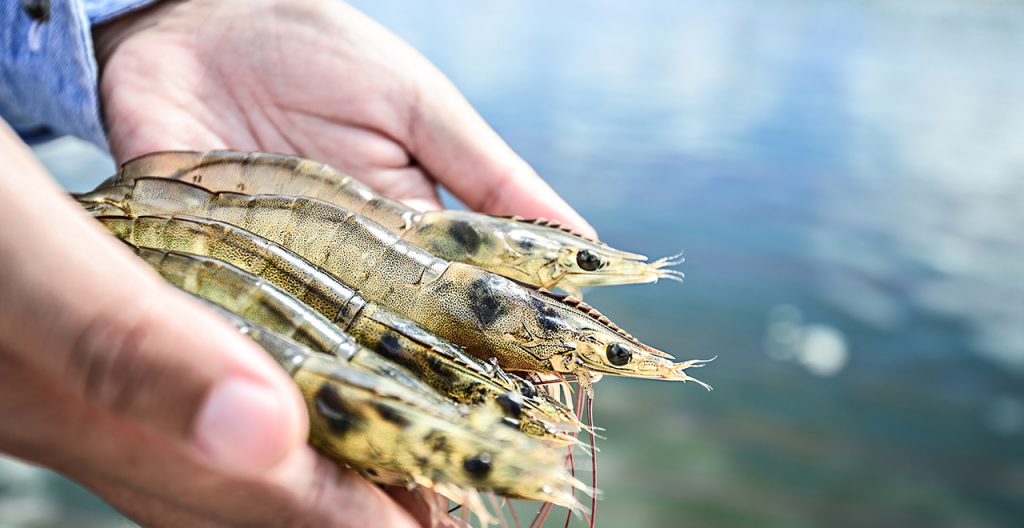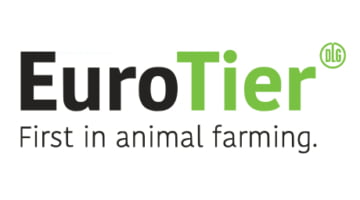PhD Orapint Jintasataporn, Department of Aquaculture, Kasetsart University, Bangkok, Thailand, 2014
Early Mortality Syndrome (EMS) or Acute Hepatopancreatic Necrosis Syndrome (AHPNS) is a dangerous disease caused by Vibrio parahaemolyticus bacteria. Since EMS was reported in China in 2009, it has spread to Vietnam, Malaysia, Thailand and Mexico causing annual losses more than U.S. $1 billion. EMS outbreaks typically occur within the first 30 days after stocking a newly prepared shrimp pond, and mortality can exceed 70%.
The disease is transmitted orally and bacteria colonize the shrimp’s gastrointestinal tract producing a toxin that causes tissue destruction and dysfunction of the shrimp digestive organ known as the hepatopancreas.
The goal of this trial was evaluate the effect of ImmunoWall® as an additive capable of reducing the impact of juvenile white shrimp (Litopenaeus vannamei) infected by Vibrios parahemolyticus bacteria that is EMS agent.
The study was assigned in 3 treatments:
- Standard commercial vannamei shrimp feed
- Commercial feed containing 5 kg ImmunoWall® per ton feed
- Commercial feed containing 10 kg ImmunoWall® per ton feed
Healthy white shrimp – PL 8 were purchased from a commercial hatchery in Chachengsao province. Shrimp was acclimated for 5 days, before allocation to treatment tanks prior to start of trial. Shrimp PL12 will be stock in 100 L glass aquarium at salinity of 20 ppt. The stocking density of the experimental animals was 180 PL12 shrimp per aquarium (360 ind./m2). Feeding frequency was 4 times per day on 07.00, 11.00, 15.00 and 19.00 pm.
Feed composition was presented in Table 1. The proximate composition of trial feed such as moisture, protein, lipid, fiber, ash, was analyzed as described by AOAC (2000).
Table 1. Experimental diet composition
|
Materials |
Control | ImmunoWall® 0.5% |
ImmunoWall® 1.0% |
|
Fishmeal, tuna |
25 | 25 | 25 |
| Shrimp meal | 10 | 10 |
10 |
|
Squid meal |
8 | 8 | 8 |
| Wheat flour | 29.3 | 28.8 |
28.3 |
|
Soybean meal 45% |
10 | 10 | 10 |
| ImmunoWall® | 0 | 0.5 |
1.0 |
|
Wheat gluten |
12 | 12 | 12 |
| Tuna fish oil | 0.5 | 0.5 |
0.5 |
|
Soya oil |
0.5 | 0.5 | 0.5 |
| Squid liver oil | 0.5 | 0.5 |
0.5 |
|
Soy lecithin |
1 | 1 | 1 |
| Polymethyl cabamide | 0.7 | 0.7 |
0.7 |
|
Vita-mineral premix |
2.5 | 2.5 | 2.5 |
| Sum | 100 | 100 |
100 |
| Proximate composition by AOAC (2000) | |||
|
Moisture(%) |
6.82 | 6.59 | 6.69 |
| Protein(%) | 46.53 | 46.13 |
46.58 |
|
Lipid(%) |
5.11 | 5.52 | 5.20 |
| Fiber(%) | 1.87 | 1.95 |
1.93 |
|
Ash(%) |
10.91 | 10.78 | 10.92 |
| Calcium(%) | 2.38 | 2.35 |
2.56 |
|
Phosphorus(%) |
1.37 | 1.46 | 1.40 |
| Gross Energy(Kcal/Kg) | 4706.53 | 4716.68 |
4712.31 |
Temperature and salinity stress tolerance
The shrimp was transferred to study tank on stress tolerance by temperature at 35oC. Each treatment had 4 replicates and 10 shrimp per replicate. The temperature was continuously increased until 35oC and controlled at this level. Mortality rate was recorded daily for 10 days.
The salinity stress tolerance study was conducted on 35 ppt level. Shrimp was transferred to test unit and reared under this condition. Each treatment had 3 replicates and 15 shrimp per replicate. Mortality rate was daily recorded for 10 days.
Disease challenge
After the 30 days from initial period, the experimental animals in each treatment were transferred to the challenge aquarium with stock 20 ind./ aquarium. Each treatment was replicated 4 times. The virulent bacteria, Vibrio parahaemolyticus, was introduced by immersion treatment to determine the ability of shrimp to resist against the pathogenic vibrio.

Vibrio parahaemolyticus cultivation
One day before the challenge, Vibrio parahaemolyticus was cultivated in nutrient broth with 1.5% Na Cl (w/v). Thirty hours after cultivation, the broth was centrifuged to collect the bacteria cell. The pathogen was washed 2-3 times and adjusted to 1012before use.
Immersion treatment
The Vibrio parahaemolyticus challenge test was study by immersion treatment on normal condition and under salinity stress condition for one day before challenge.
Eighty shrimp from each treatment were randomly collected and transferred to stock in aquaria of 50 L with water level of 20 L and 20 ppt sea water for normal condition. The challenge test was replicated 4 times per treatment with twenty shrimp per replicate. Shrimp was challenged by immersion treatment at infection dose of 1.0-2.9 x 1012 CFU/mL. Strong aeration was supplied to the water during challenging period. Mortality rate was recorded every day for 10 days. Vibrio spp. was counted from hepatopancrease of each group after 5 days of challenge by TCBs agar to confirm the pathogen contamination and shrimp immunity to defense themselves from bacteria.
For salinity stress condition and challenge by immersion, forty five shrimp from each treatment were transferred to stock in aquaria of 50 L with water level of 20 L and 5 ppt sea water. The challenge test was replicated 4 times per treatment with fifteen shrimp per replicate. Shrimp was challenged by immersion treatment at infection dose of 3.0-3.5 x 1012 CFU/mL. Strong aeration was supplied to the water during challenging period. Mortality rate was recorded every day for 10 days. Vibrio spp. was counted from hepatopancrease of each group after 5 days of challenges by TCBs agar to confirm the pathogen contamination and shrimp immunity to defense themselves from bacteria.
This study was conducted in completely randomized design (CRD). All data was analyzed by one-way ANOVA (analysis of variance). The Duncan’s Multiple Range Test was used to determine the differences between the treatments means. All research was conducted at the Nutrition and Aquafeed Laboratory, Department of Aquaculture, Faculty of Fisheries, Kasetsart University, Bangkok, Thailand.
Results
The results of temperature and salinity stress tolerance of white shrimp fed different diets were presented in Table 3 and 4. The results showed that there were not significantly difference (p>0.05) on mortality of shrimp after temperature and salinity stress for 10 days. High temperature of 35 oC induces mortality on 4 initial days. After that shrimp can tolerate this high temperature condition. For salinity stress, all shrimp survive under the proposed condition meaning shrimp can adapt their physiology in high salinity environment.
Table 3. Percentage of accumulated mortality rate of white shrimp (Litopenaeus vannamei) stress test by temperature 35oC.
| Day after challenge | Control | ImmunoWall® 0.5% | ImmunoWall® 1.0% |
P-value |
|
|
Mortality rate(%) |
60.00 a | 57.50 a | 47.50 a | 0.816 | |
| Survival rate(%) | 40.00 a | 42.50 a | 52.50 a |
0.816 |
|
Note: a,b Values with different superscripts in a row showed differ significantly (P < 0.05).
Table 4. Percentage of accumulated mortality rate of white shrimp (Litopenaeus vannamei) salinity stress test at 35 ppt.
|
Day after stress |
Control | ImmunoWall® 0.5% | ImmunoWall® 1.0% |
P-value |
|
Mortality rate(%) |
0 | 0 | 0 | …… |
| Survival rate(%) | 100 | 100 | 100 |
…… |
Note: Values in each treatment were the same, no statistical analysis
Focusing on the effect of ImmunoWall® on disease resistance of white shrimp (Litopenaeus vannamei) by immersion treatment in Table 5 and 6. The results showed significantly difference (p<0.05) after challenge by Vibrio parahaemolyticus both under normal and salinity stress condition.
Under normal condition (Table 5), the mortality rate of control group was higher (p<0.05) than group of shrimp fed ImmunoWall®. The Vibrio spp. count from shrimp hepatopancreas after challenge of white shrimp demonstrated that group of shrimp fed 1% ImmunoWall® had improved hemolymph ability to defense themselves against virulent bacteria followed by 0.5% ImmunoWall® and control, respectively.
Under 35 ppt stress condition, the mortality of shrimp after challenge by Vibrio parahaemolyticus (Table 6) showed significantly difference (p<0.05). Shrimp fed ImmunoWall® exhibited the lower mortality (p<0.05). The Vibrio spp. count from shrimp hepatopancreas after challenge demonstrated that group of shrimp fed 1% ImmunoWall® had better hemolymph ability to defense themselves against virulent bacteria better than 0.5% ImmunoWall® and control, respectively.
Table 5. Percentage of accumulated mortality rate of white shrimp (Litopenaeus vannamei) challenged by immersion treatment of Vibrio parahaemolyticus infected dose 1012 cfu/ml
|
Day after challenge |
Control | ImmunoWall® 0.5% | ImmunoWall® 1.0% |
P-value |
|
day 1 |
0.0 | 0.0 | 0.0 | … |
| day 2 | 6.3 a | 2.5 b | 0.0 b |
0.003 |
|
day 3 |
11.3 a | 6.3 b | 2.5 bc | 0.001 |
| day 4 | 15.0 a | 6.3 b | 5.0 b |
0.008 |
|
day 5 |
18.8 a | 6.3 b | 6.3 b | 0.004 |
| day 6 | 18.8 a | 6.3 b | 6.3 b |
0.007 |
|
day 7 |
18.8 a | 7.5 b | 6.3 b | 0.010 |
| day 8 | 18.8 a | 7.5 b | 6.3 b |
0.010 |
|
day 9 |
18.8 a | 7.5 b | 6.3 b | 0.010 |
| day 10 | 20.0 a | 7.5 b | 6.3 b |
0.004 |
|
Mortality rate(%) |
20.0 a | 7.5 b | 6.3 b | 0.004 |
|
Vibrio spp. count (cfu/g) |
2.6X104a |
3.2 X103c | 1.3 X103c |
<0.001 |
| Vibrio spp. count (Log cfu/g) | 4.41a | 3.50c | 3.12d |
<0.001 |
Note: a,b Values with different superscripts in a row showed differ significantly (P < 0.05).
Table 6. Percentage of accumulated mortality rate of white shrimp (Litopenaeus vannamei) salinity stress test at 35 ppt and challenged by immersion treatment of Vibrio parahaemolyticus infected dose 1012 cfu/ml.
|
Day after stress |
Control | ImmunoWall® 0.5% | ImmunoWall® 1.0% |
P-value |
|
day 1 |
51.11 a | 28.89 b | 24.44 b | 0.020 |
| day 2 | 66.67 a | 42.22 b | 35.56 b |
0.020 |
|
day 3 |
73.33 a | 48.89 b | 40.00 bc | <0.001 |
| day 4 | 82.22 a | 53.33 b | 44.44 bc |
<0.001 |
|
day 5 |
86.67 a | 53.33 b | 46.67 b | <0.001 |
| day 6 | 93.33 a | 55.56 b | 48.89 b |
<0.001 |
|
day 7 |
95.56 a | 55.56 b | 48.89 b | <0.001 |
| day 8 | 95.56 a | 55.56 b | 48.89 b |
<0.001 |
|
day 9 |
95.56 a | 55.56 b | 48.89 b | <0.001 |
| day 10 | 95.56 a | 55.56 b | 48.89 b |
<0.001 |
|
Mortality rate(%) |
95.56 a | 55.56 b | 48.89 b | <0.001 |
| Vibrio spp. count (cfu/g) | 9.6 X106a | 2.5 X106bc | 3.2 X105d |
<0.001 |
|
Vibrio spp. Count (Log fu/g) |
6.98a | 6.38b | 5.43d | <0.001 |
Note: a,b Values with different superscripts in a row showed differ significantly (P < 0.05).
Conclusion
ImmunoWall® showed to be effective reducing mortality in shrimps Litopenaeus vannamei submitted to stress temperature, high salinity and immersion with Vibrio parahaemolyticus, which is the EMS agent.
Best results were obtained with ImmunoWall® for both inclusion levels associated with high salinity (35 ppt). As Vibrio parahaemolyticus is a halophile bacterium, it develops and thrives better on medium to high salinity by enhancing the immune modulation activity of ImmunoWall®, which increased the survival of shrimp by 50% compared to control diet group.
For further information: [email protected]
发布于: 04 十一月 of 2016

